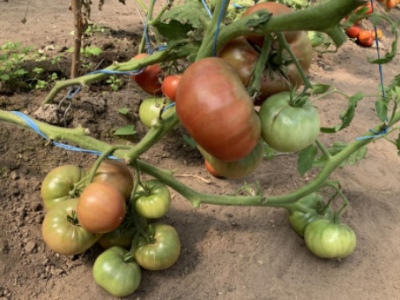
- Authors: USA
- Name synonyms: Carbon, Carbon
- Category: grade
- Growth type: indeterminate
- Appointment: fresh consumption
- Ripening period: mid-season
- Ripening time, days: 110-120
- Growing conditions: for greenhouses
- Marketability: high
- Bush size: tall
Tomatoes from the New World can confidently challenge many of the familiar varieties bred in Russia and Europe. Tomato Carbon is just such a candidate for success. However, brilliant results in its cultivation await only those who thoroughly study this culture.
Breeding history
Such a tomato was developed by US breeders. In this country, the variety is called Carbon. In Russian-language sources, the name Carbon is often used (from English this word is translated as "carbon"). The official description states that Carbon is a classic grade. However, unofficial sources sometimes claim that this is a hybrid plant.
Description of the variety
In Russia and other Eastern European countries, this culture is still little known. Carbon is characterized by an indeterminate course of development. Therefore, his bushes will have to be looked after very carefully. Basically, this plant is intended for greenhouses. Outside protected ground, it can be cultivated only in the warmest regions of Russia.
But even there it makes little sense to conduct such experiments. Carbon bushes are high. They are able to grow up to 1.5-1.8 m. The average level of branching is typical for them. The foliage is also average, which is quite popular with many people.
The main qualities of the fruit
Carbon tomatoes are highly marketable. When ripe, they are colored in a purple-cherry tone. These large berries weigh 0.15-0.2 kg. Also characteristic:
- flat-round configuration;
- 5 or 6 fruits in each cluster;
- dark crimson color of the soft mass.
Taste characteristics
Tomato Carbon is sweet. Its pulp is always tender. The official description emphasizes the invariable juiciness of the fruit. The fleshy and oily berries are also noted. Additionally, you should pay attention to the unobtrusive spicy shade.
Ripening and fruiting
Carbon belongs to the mid-season category. Under normal (corresponding to the varietal description) conditions, the harvest can be obtained in 110-120 days. The starting point is traditionally the appearance of the first green shoots. From the moment the berries are formed, they will form for a long time.
Yield
The plant is classified as a high-yielding category. It can give from 7 to 9 kg (calculation per square meter). However, in specific situations, productivity is often different. It is worth emphasizing the importance of both weather and agricultural technology. The collected fruits can be eaten fresh.
The timing of planting seedlings and planting in the ground
It is necessary to plant seeds in containers at the same time as the planting material of other mid-season varieties. In the south, it is necessary to sow seeds for seedlings in mid-March. In the middle lane, the right moment comes at the junction of March and April. If the weather is not very good, it is better to postpone the landing until the second half of April. Landing in garden soil is carried out when heated to 15 degrees, in greenhouses a level of 10 degrees is enough.

Growing tomato seedlings is an extremely important process, because it largely depends on whether the gardener can harvest at all. All aspects must be taken into account, from seedbed preparation to planting in the ground.
Landing scheme
Planting more than 4 specimens on a square meter of soil is not allowed. It is even better to reduce this number by 1 or 2 plants to make planting easier. 40 cm is usually left between the holes.

Growing and care
It will be necessary to remove stepchildren and form bushes in any case. Formation takes place in 2 or 3 stems. Carbon does not tolerate intense heat and excessive moisture. In the southern regions, it is impossible to count on getting elegant berries in large quantities without shading with special nets.
Irrigation of tomatoes should be done regularly. At the same time, waterlogging should not be allowed, even for a short period. Carbon requires a set of vegetative mass in the first half of the season. Therefore, during this period, he needs a significant amount of nitrogen supplements. When the second flower cluster is formed, the generative stage begins, in which nitrogen replenishment is minimized. Important: The reaction to an excessive amount of nitrate will be more pronounced than with many other varieties of tomatoes.
Strong support is very important for Carbon. Step-sons should be removed even if not too aggressively, but regularly. When pouring brushes, foliage should be removed under them. In open gardens during a rainy period, it is advisable to stretch the plastic wrap. The shaping should be done late enough, especially in greenhouse cultivation.
At the very end of the growing season, there can be a sharp rise in productivity. At this point, the tomato quickly forms and ripens into large tomatoes. Pinching the crown is not required, because the plant itself stays growing. It should be borne in mind that Carbon reacts sharply to a dismissive approach. However, the plant tolerates the main tomato pathologies.
Immunity is very good in relation to late blight. In hot weather, foliage can burn if plant maintenance is inadequate. The likelihood of being damaged by pests is moderately high. It is also worth noting that yields can be unstable.
Carbon needs great lighting. Soil with weak or neutral acidity is also very important for plants. Good drainage is just as important. Before planting, the use of rotted organic fertilizers is recommended. Loosening around the bush should be done regularly.




A plant needs different micronutrients at each stage of growth. All fertilizers can be divided into two groups: mineral and organic. Folk remedies are often used: iodine, yeast, bird droppings, eggshells.
It is important to observe the rate and period of feeding. This also applies to folk remedies and organic fertilizers.



























































































